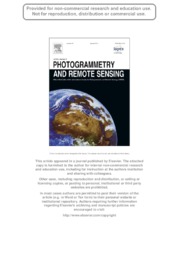A comparative analysis of ALOS PALSAR L-band and RADARSAT-2 C-band data for land-cover classification in a tropical moist region.
A comparative analysis of ALOS PALSAR L-band and RADARSAT-2 C-band data for land-cover classification in a tropical moist region.
Summary: This paper explores the use of ALOS (Advanced Land Observing Satellite) PALSARL-band (Phased Array type L-band Synthetic Aperture Radar) and RADARSAT-2 C-band data for land-cover classification in a tropical moist region. Transformed divergence was used to identify potential textural images which were calculated with the gray-level co-occurrence matrix method. The standard deviation of selected textural images and correlation coefficients between them were then used to determine the best combination of texture images for land-cover classification. Classification results based on different scenarios with maximum likelihood classifier were compared. Based on the identified best scenarios, different classification algorithms ? maximum likelihood classifier, classification tree analysis, Fuzzy ARTMAP (a neural-network method), k-nearest neighbor, object-based classification, and support vector machine were compared for examining which algorithm was suitable for land-cover classification in the tropical moist region. This research indicates that the combination of radiometric images and their textures provided considerably better classification accuracies than individual datasets. The L-band data provided much better landcover classification than C-band data but neither L-band nor C-band was suitable for fine land-cover classification system, no matter which classification algorithm was used. L-band data provided reasonably good classification accuracies for coarse land-cover classification system such as forest, succession, agropasture, water, wetland, and urban with an overall classification accuracy of 72.2%, but C-band data provided only 54.7%. Compared to the maximum likelihood classifier, both classification tree analysis and Fuzzy ARTMAP provided better performances, object-based classification and support vector machine had similar performances, and k-nearest neighbor performed poorly. More research should address the use of multitemporal radar data and the integration of radar and optical sensor data for improving land-cover classification.
Publication year: 2012
Types of publication: Journal article
Unit: Embrapa Territorial
Keywords: ALOS PALSAR, Amazon, Land-cover classification, RADARSAT, texture
Observation
Some of Embrapa's publications are published as ePub files. To read them, use or download one of the following free software options to your computer or mobile device. Android: Google Play Books; IOS: iBooks; Windows and Linux: Calibre.
Access other publications
Access the Agricultural Research Database (BDPA) to consult Embrapa's full library collection and records.
Visit Embrapa Bookstore to purchase books and other publications sold by Embrapa.

